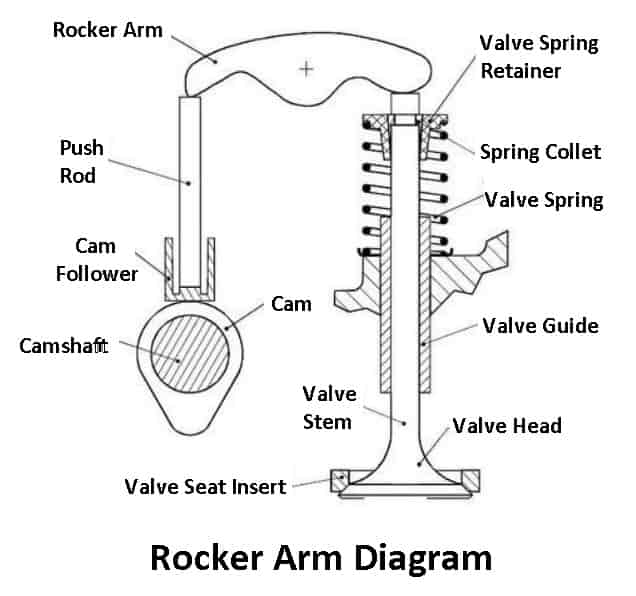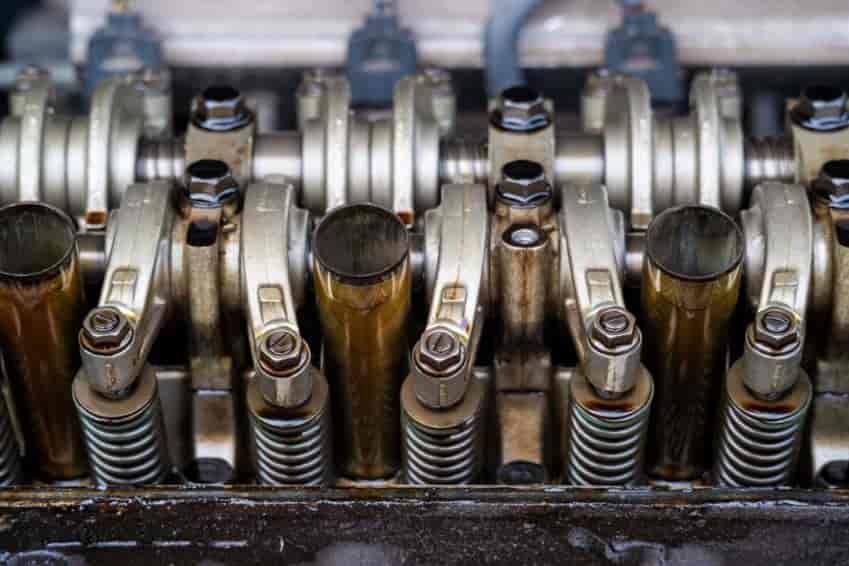Hello readers! In this post, we’ll discuss what is a rocker arm? Its Diagram, Parts, Function, Material, Types, Advantages and Uses using illustrations.
You can also download the PDF file of this article at the end.
What are Rocker Arms?
Rocker arms are a centrally pivoting lever in an engine’s valve train that transfers rod motion to open the valves of the engine. it is operated by a pushrod from the camshaft.
It’s a procedure that happens when these components come into direct contact with the tappets and by the shaft’s movement.
Rocker arm one end is in contact with the tappet, while the other is connected to the intake and exhaust valves. As a result, when the camshaft cam triggers the rocker arm, one of its sides lowers, allowing the valve to open and allow air and fuel to enter. This action occurs for both valves of the engine.
A spring, in turn, supports the displacement and pushes the valves back to their starting positions. Since the process occurs at extreme speeds and maintains constant contact with the rocker arms, the springs must be long-lasting.
Most car rocker arms are made of stamped steel or, for higher-revving models, aluminum is generally used. Some roller rockers, or rocker arms, feature a bearing at the contact point to reduce wear and friction.
Definition of Rocker Arm:
The component that transfers the camshaft’s movement to the intake and exhaust valves of the engine is called the rocker arm.
Parts of Rocker Arm
The primary parts of an engine that operates with the rocker arm are as follows:
- Rocker
- Pushrod
- Tappet
- Cam
- Valve spring
- Valve
#1 Rocker
A rocker is usually used in internal combustion engines to convey the motion of a pushrod to the appropriate intake/exhaust valve.
#2 Pushrod
At the top of the engine, the pushrod presses against the rocker’s arm (located on one side) and causes it to rotate. When the rocker arms rotates, the top of the valve is pressed downward by the other end, opening the valve by moving it downward.
#3 Tappet
In an internal combustion engine, the group of mechanical components situated between the camshaft and the valve is referred to as the tappet. These components transfer the camshaft’s rotational movement and convert it into the poppet valve’s alternating linear movement, which opens and closes the valve.
#4 Cam
The camshaft converts rotational motion into reciprocating motion, which causes the valves to open and close at the right time. The rocker arms, a lever fixed on a fulcrum, receives motion from the pushrod, which is moved up and down by the lifter on the cam lobe.
#5 Valve Spring
The valve spring aids in keeping the valve closed. In overhead valve engines, the spring provides back pressure to the rocker arms and cam bucket.
#6 Valve
A camshaft cam triggers the rocker arm to lower one of its sides, allowing the valve to open so that the fuel and air mixture can enter the combustion chamber. This movement occurs for both intake and exhaust valves.
Rocker Arm Diagram

Read Also: Different Types of Car Sensors Used In Cars
Functions of Rocker Arms
It is critical to know about the function of a rocker’s arm to gain a better understanding of its role in cars.
This component acts like a lever inside an engine, allowing it to move parts such as pushrods, valves, and lifters within the engine.
When the rocker arm rotates, the lobe-shaped nodes on the camshaft engage with it. These nodes rotate and cause the rocker arm to move up and down.
Consequently, this process converts the mechanical energy into a force that presses against an engine valves. In this technique, hydraulic pressure or spring pressure are employed.
The remaining fuel and air are allowed to pass through the valves, which open and close at regular intervals to exhaust the remaining fuel in each cylinder during combustion.
Read Also: Different Types of Engines and Their Applications Explained
Types of Rocker Arms
The following are the main types of rocker arms:
- Stamped Steel Rocker Arm
- Roller-Tipped Rocker Arm
- Full Roller Rocker Arm
- Shaft Rocker Arm
#1 Stamped Steel Rocker Arm
It is the most popular type of rocker arm. These are generally made of stamped steel. Stamped steel rocker arms are the easiest and least expensive to make since they are stamped from a single piece of metal.
The rocker is kept in place by a trunnion pivot. It has a nut with a rounded bottom. This is a really simple way to allow the rocker to travel up and down while keeping it secure.
#2 Roller-Tipped Rocker Arm
These types of rocker arms resemble stamped steel rockers in that they have a roller added to the valve end tip of the rocker arm. This leads to less friction, somewhat increased power, and reduced wear on the valve tips.
For simplicity, the trunnion pivot nut and stud are still used in the Roller Tipped Rocker Arm. They can also be formed from steel, aluminum, castings, or machined parts.
#3 Full Roller Rocker Arm
This rocker arm represents a full roller rocker arm, not just a stamped steel rocker. They are generally constructed of machined steel or aluminum. In this type, the trunion pivot is replaced with bearings.
The stud from the trunnion pivot is still in use, however they do not utilize the nut. They feature a tiny shaft that is tightly screwed into position and has bearings inside the rocker on both ends, allowing the rocker to rotate.
#4 Shaft Rocker Arm
The shaft rocker arms are built based on full roller rocker arms. A shaft that connects these rocker arms. In certain circumstances, the shaft may pass through all of the rocker arms. In other cases, it may pass through only two, depending on how the head was built.
The usage of a shaft is required for rigidity. The stronger the valve train, the less it deflects and the less likely it is to move uncontrollably at higher RPMs.
Read Also: Difference Between Petrol and Diesel Engines [Explained]
Rocker Arm Materials
Historically, stamped steel rocker arms have been used for mass-produced automobile engines, since they are more cost-effective.
The reciprocating weight of the valvetrain is supported by the rocker arms. As engine speeds (RPM) increase, it may become problematic. Because of this, engines with higher RPMs frequently use aluminum.
Sometimes, engines running at high RPM additionally employ upgraded bearings for the fulcrum of the rocker arm.
Rocker arms for diesel truck engines are frequently made of forged carbon steel or cast iron, which is typically ductile.
Symptoms of Rocker Arm
You can’t drive your car with a damaged rocker arm if it is not fixed. Following are the signs that may indicate a malfunctioning rocker arm.

#1 Clicking or Ticking Noise
Clicking or ticking noises are among the most typical signs of worn rocker arms. These sounds typically come from the top of the engine.
However, the other parts can make the same noises, so have your car checked by an experienced mechanic for a precise diagnosis.
#2 Illuminated Check Engine Light
There are several possible causes of a check engine light, such as broken rocker arms or other connected problems.
A P2647 code or a P2646 code could indicate that the powertrain control module (PCM) was capable of logging rocker arm-related trouble codes.
#3 Engine Misfire
The rocker arms are crucial in the fuel combustion process. If it is damaged, your car could suffer symptoms such as stalling or misfiring.
Read Also: Types of Cooling System In Automobile Engines
Advantages of Rocker Arm
Following are the few advantages of rocker arm:
- It is responsible for transmitting the motion of the camshaft to open the valves.
- It converts the rotary motion of the camshaft into vertical motion to open and close the valves.
- Rocker arms help in the distribution of wear and load on the camshaft.
- Without rocker arms, the valves would be directly impacted by the lobes of the camshaft, increasing wear and possibly resulting in premature failure.
- Certain engine designs feature movable rocker arms that enable precise valve clearance adjustment.
- Rocker arms help to simplify and compact valve train geometry.
- Rocker arms, as compared to direct-acting valve systems, can lower the overall inertia of the valve train. It helps to improve engine responsiveness, especially at higher RPMs.
Disadvantages of Rocker Arm
Following are the few disadvantages of rocker arm:
- Due to their frequent movement and contact with other engine parts, they are subject to wear and friction. This may result in more frequent maintenance needs.
- In an engine, rocker arms contribute to the complexity of the valvetrain.
- Because rocker arms add weight to the engine, vehicle engineers frequently focus on decreasing weight for optimal performance and fuel economy.
- This can lead to valvetrain noise, particularly in engines that have aggressive cam profiles and increased valve lift.
- The continual movement and stresses on rocker arms might eventually lead to fatigue and failure.
Closing It Up
So now, I hope I’ve covered everything about the “Rocker Arm Parts and Working“. If you have any questions or doubts about this article, you can ask in the comments. If you liked this article, then please share it with your friends.
Subscribe to our newsletter to be notified when we upload new posts.
Download PDF of this article:
You may like to read more interesting articles on our blog: